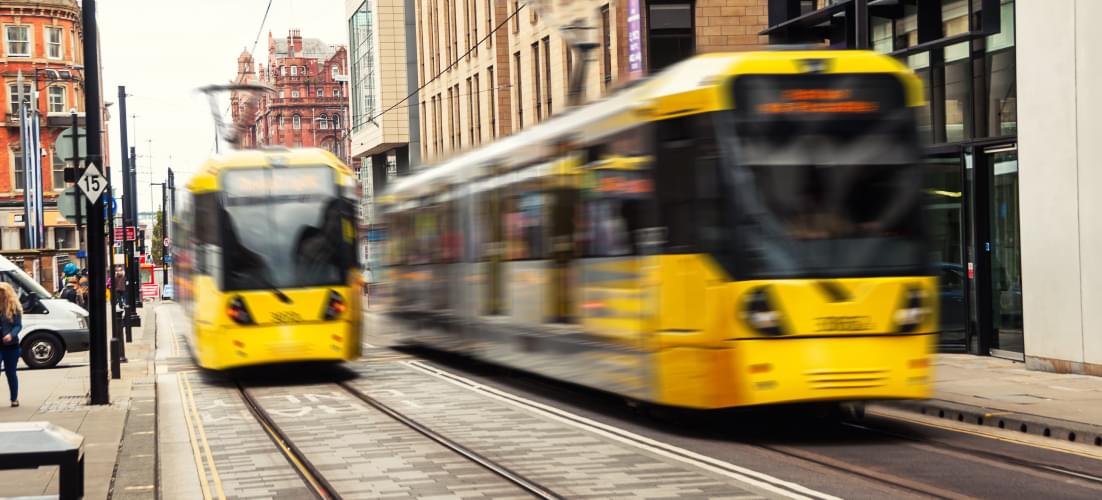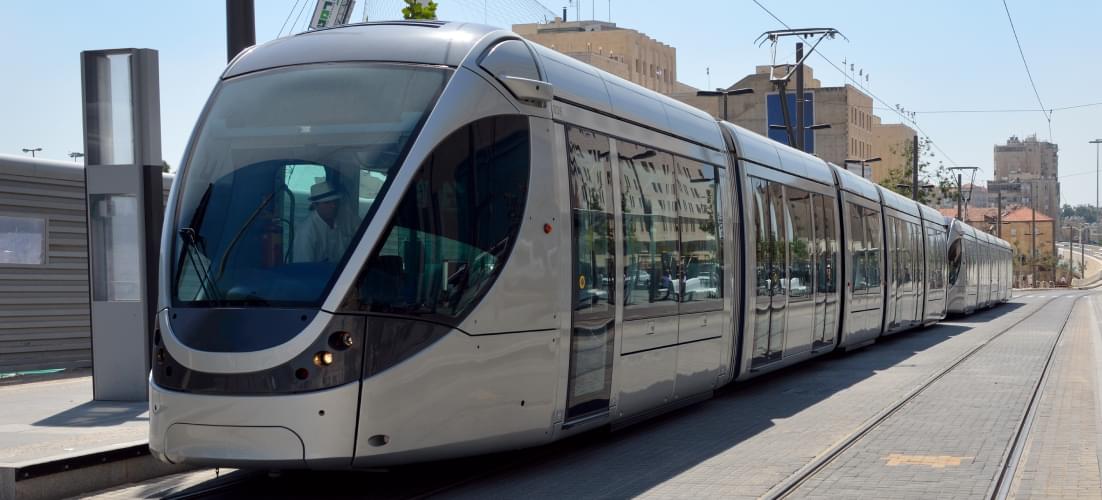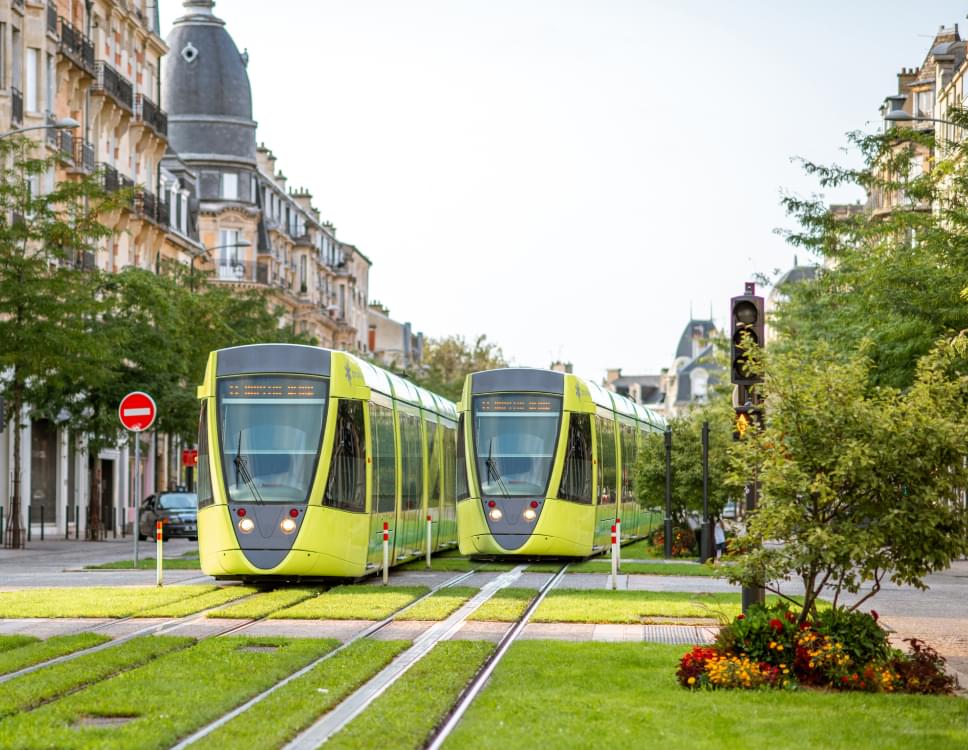UrbanTwinTrain solution for traffic problems. Мakes it possible to double the maximum number of passengers transported in the city without worsening traffic conditions
On the periphery, where the distance between stops is long, the UrbanTwinTrain trams run singly.
Closer to the city centre, the UrbanTwinTrain trams assemble in pairs, while:
- at intersections with heavy cross-traffic - trams run in pairs, each way simultaneously on both tracks, taking up minimal space and thus not obstructing the cross-traffic flow;
- at intersections with low volume of cross-traffic - oncoming tram pairs rearrange and separate without significantly impeding the cross-traffic flow.
Then the UrbanTwinTrain trams move in pairs simultaneously on two tracks in each direction with priority passage at intersections.
Having traveled through the city center, pairs of UrbanTwinTrain trams are divided for further movement along their routes.
Convenient and fast communication of the city center with the suburbs without transfers and congestion, solutions reduce traffic congestion
In the suburbs, trains UrbanTwinTrain with a length of 67m move in pairs one after the other with a minimum distance. To stop, they use platforms only of their own path. Such pairs of trains have the length and capacity of ordinary suburban trains.
In a city where the tram network is used and the distances between stops are reduced, and classic suburban trains do not fit at small stopping points – some trains UrbanTwinTrain are rebuilt on the adjacent track and then pairs of trains run simultaneously on two tracks and use platforms of both tracks. At the same time, the space occupied at stops and when passing intersections is reduced by half. The passage of oncoming pairs of trains UrbanTwinTrain is carried out due to realignments on lightly loaded sections of traffic.
As a result, the number of passengers transported doubles without complicating the road situation, there is no need to build overpasses, tunnels and interchanges for the movement of such trains in urban conditions.
When moving to the suburbs, pairs of trains again occupy one track for further movement along their route.
The high speed of trams in the center remains, no crowding, no interference with other transport at intersections, solutions for urban congestion.
The maximum number of passengers transported is doubled without interference to other transport and the traffic situation is improving. Trams move at minimum intervals of 4min 30sec or more and have a traffic coordination system.
Parallel traffic in the general traffic flow allows to occupy a minimum of places when passing intersections, while the construction of tunnels, overpasses and interchanges is not required.
- High carrying capacity by doubling trams on the line without obstructing other transport.
- Convenient and quick connection of the city center with the suburbs.
Due to the increased number of trams, coverage of a larger area of the suburbs without accumulating trams in the city center.
- Better comfort of the trip and more vacant seats due to the increase of free space.
- Higher speed and shorter travel time.
- UrbanTwinTrain does not require a substantial overhaul of the road surface infrastructure and the construction of expensive interchange racks.
- UrbanTwinTrain applicable for both rail transport (trams, LRT) and BRT (buses).
Demonstration of the UrbanTwinTrain traffic with side and island-type stopping points in comparison with the traditional traffic scheme of an urban tram. Traffic congestion problems and solutions
Comparison of UrbanTwinTrain with the traditional traffic pattern of 67m city tram at traffic intervals of 4min 30sec.
UrbanTwinTrain demonstrates a clear advantage - doubled carrying capacity - 12000 - 16000 people/h, with the same congestion at intersections due to the movement of trams in pairs on both tracks. The low level of congestion is ensured by the movement of trams in pairs, parallel along two tracks on sections of the route with intersections with heavy traffic, without creating significant congestion. In places and at intersections with non-intensive traffic, oncoming pairs of UrbanTwinTrain are passing, also without creating significant obstacles to other transport. Due to this, in such sections and on the route as a whole, the level of traffic jams remains within the standard traffic pattern, but with a twofold increase in maximum carrying capacity. Тraffic problems and solutions
Comparison of UrbanTwinTrain with the traditional traffic scheme of an urban tram with a length of 67m and carrying capacity of 12000 - 16000 people/hour.
To transport 12000 - 16000 people/hour in one direction, pairs of trams UrbanTwinTrain (the length of one tram is 67m, the capacity is 460-600 people) requires a traffic interval of 4min 30sec. At the same time, with a classic traffic pattern of 67m trams, there is either a low carrying capacity of 6000 people/h or, when trying to increase it by reducing traffic intervals to 2min 15sec, 8-10 point traffic jams on city roads due to the frequent closure of intersections for other traffic participants.
Comparison of UrbanTwinTrain with the traditional 67m urban tram traffic pattern in the route tangency section at traffic intervals of 4min 30sec on each route.
When using the classical traffic pattern, 8-10 point traffic jams are formed in such a section due to the frequent closure of intersections for other participants in cross-traffic. Moreover, especially at the fork before the stopping point, due to the constant employment of the latter and the forced waiting for the next tram in the queue to arrive at the platform. When using UrbanTwinTrain, trams arrive at the stopping point to both platforms in each direction, which allows to keep the traffic interval of 4min 30sec, while increasing the carrying capacity to 12000 - 16000 people/h.
UrbanTwinTrain parallel movement
A pair of separate trams UrbanTwinTrain of a large total capacity moves parallel to each other in the same direction along different tracks. The advantage of parallel traffic is saving space on the road and minimizing the time to overcome intersections, without creating additional traffic jams and doubling the number of passengers transported. When the oncoming trams approach, their passing is carried out by changing lanes by each of them into one route and further passing of each group along its own path.


UrbanTwinTrain sequential movement
It is used when passing of the oncoming pairs of trams UrbanTwinTrain is necessary. UrbanTwinTrain trams move in the same direction along the same path with a minimum distance. After passing apart, when approaching the stopping point, one of them remains in its track and the other leaves on the oncoming one, then each tram stops at its platform for boarding and disembarking passengers.
Automation and safety at crossroads
When a pair of individual trams UrbanTwinTrain approach the intersection, a traffic light enabling signal is turned on for them in advance. This happens automatically when approaching the intersection of the first tram. This provides a green wave mode for non-stop crossing of intersections by trams with the priority over the rest of the traffic. At the same time, the trams of each group are equipped with matching devices that ensure their movement in each group in order to regulate traffic depending on the movement of the tram of the same group. Due to the automation and remote control, an effective and safe minimum distance between trams in each group is provided, the total employment time of intersections on the route for other traffic participants is comparable to the classic traffic scheme, but at the same time, double number of trams is ensured through these intersections. In the case of parallel traffic in one direction, the trams are located offset from each other, allowing for safe traffic in the group, comparable to the traditional traffic pattern.

UrbanTwinTrain is aimed at solutions to traffic congestion in cities:
Congestion
Existing public transport systems are no longer able to cope with increasing passenger traffic during rush hours.
Congestion on the roads
Endless congestion and loss of time in traffic jams have become commonplace in large cities, which the usual methods can no longer cope with.
Ecology
Emissions of exhaust gases, oils and fine dust from tyre and pavement wear lead to a wide range of chronic diseases.
 Passenger traffic
Passenger traffic2x increase in passenger traffic compared to traditional tram traffic system
 Environmental friendliness
Environmental friendlinessNo harmful emissions
to the atmosphere
 Traffic jams
Traffic jamsMinimal impact on other road users
 Safety
SafetyThere is no need to move to another platform through the roadway
Frequently Asked Questions
UrbanTwinTrain is suitable for cities that are considering building an underground or LRT or that require a public transport capacity of more than 7,000 people per hour. Unlike the underground, it is quicker to implement and much cheaper, both during construction and operation.
By increasing the frequency of trams, the employment time and the number of congested intersections for other traffic participants will increase, which, in turn, will lead to an increase in congestion and, accordingly, the collapse of the entire transport system.
- Example 1:
reducing the intervals of 45-meter trams with priority passage of intersections from 4 to 3 minutes, will cause an increase in traffic jams at intersections at 70% or more;
- Example 2:
sequential movement of two 45-meter trams with priority passage one after another with an interval of 5 minutes will cause their additional stop at each stop for 42 seconds or more, as well as the duration of the prohibition signal at traffic lights for other traffic participants will increase by 53 seconds, and in case of waiting for travel and oncoming tram - 180 seconds or more, which will also cause a transport collapse.
The minimum interval for trams with a length of 67m, having priority passage of intersections, is 4 minutes. With a further decrease in the interval, the busy time and the number of congested intersections for other traffic participants will increase, which, in turn, will lead to an increase in congestion and, accordingly, a collapse of the transport system. If to make trams without priority travel, traffic jams will be formed at traffic lights because of trams with an unacceptable slowdown in their traffic.
Due to the parallel movement of trams and the possibility of increasing the intervals between groups of trains, the number of congestion at intersections is reduced, and the maximum number of passengers transported is doubled.
At the same time:
- at intersections with non-intensive cross-traffic, oncoming pairs of trams are separated without creating significant obstacles to other transport due to its small number;
- at intersections with heavy cross traffic, trams move in pairs along both tracks, occupying a minimum of space and due to this also creating no obstacles to traffic flow.

Our Mission - Urban congestion solutions
Our advances in transport technology enable road administrations around the world to upgrade their public transport systems without significantly redesigning them, while significantly increasing the carrying capacity of land public transport without affecting the intensity and routes of other road users.
We aim to give people the opportunity to enjoy comfortable, inexpensive and fast travel by environmentally friendly and affordable transport anywhere in the metropolis!